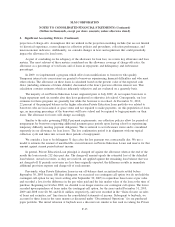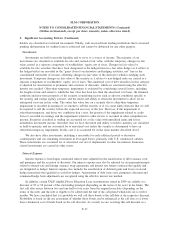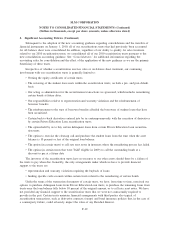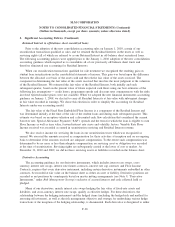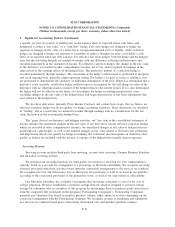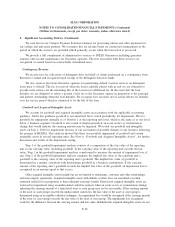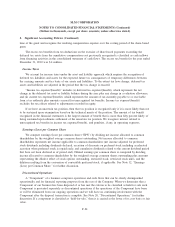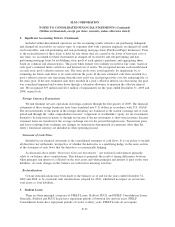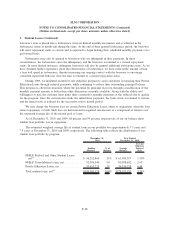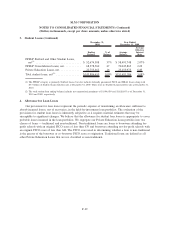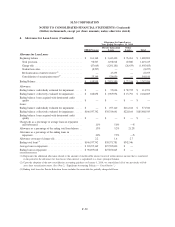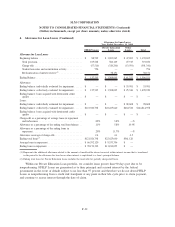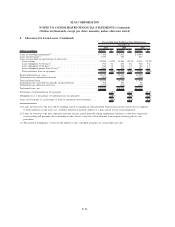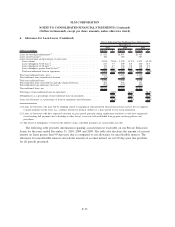Sallie Mae 2010 Annual Report Download - page 128
Download and view the complete annual report
Please find page 128 of the 2010 Sallie Mae annual report below. You can navigate through the pages in the report by either clicking on the pages listed below, or by using the keyword search tool below to find specific information within the annual report.2. Significant Accounting Policies (Continued)
Included within discontinued operations are the accounting results related to our purchasing delinquent
and charged-off receivables on various types of consumer debt with a primary emphasis on charged-off credit
card receivables, and sub-performing and non-performing mortgage loans (Purchased Paper businesses). Prior
to the reclassification of these loans to held for sale where they are carried at the lower of historical cost or
fair value, we accounted for these investments in charged-off receivables and sub-performing and non-
performing mortgage loans by establishing static pools of each quarter’s purchases and aggregating them
based on common risk characteristics. The pools when formed were initially recorded at fair value, based on
each pool’s estimated future cash flows and internal rate of return. We recognized income each month based
on each static pool’s effective interest rate. The static pools were tested quarterly for impairment by re-
estimating the future cash flows to be received from the pools. If the new estimated cash flows resulted in a
pool’s effective interest rate increasing, then this new yield was used prospectively over the remaining life of
the static pool. If the new estimated cash flows resulted in a pool’s effective interest rate decreasing, the pool
was considered impaired and written down through a valuation allowance to maintain the effective interest
rate. We recognized $79 million and $111 million of impairments for the years ended December 31, 2009 and
2008, respectively.
Foreign Currency Transactions
We had financial services operations in foreign countries through the first quarter of 2009. The financial
statements of these foreign businesses have been translated into U.S. dollars in accordance with U.S. GAAP.
The net investments of the parent in the foreign subsidiary are translated at the current exchange rate at each
period-end through the “other comprehensive income” component of stockholders’ equity for net investments
deemed to be long-term in nature or through net income if the net investment is short-term in nature. Income
statement items are translated at the average exchange rate for the period through income. Transaction gains
and losses resulting from exchange rate changes on transactions denominated in currencies other than the
entity’s functional currency are included in other operating income.
Statement of Cash Flows
Included in our financial statements is the consolidated statement of cash flows. It is our policy to include
all derivative net settlements, irrespective of whether the derivative is a qualifying hedge, in the same section
of the statement of cash flows that the derivative is economically hedging.
As discussed above under “Restricted Cash and Investments,” our restricted cash balances primarily
relate to on-balance sheet securitizations. This balance is primarily the result of timing differences between
when principal and interest is collected on the trust assets and when principal and interest is paid on the trust
liabilities. As such, changes in this balance are reflected in investing activities.
Reclassifications
Certain reclassifications have been made to the balances as of and for the years ended December 31,
2009 and 2008, to be consistent with classifications adopted for 2010, which had no impact on net income,
total assets or total liabilities.
3. Student Loans
There are three principal categories of FFELP Loans: Stafford, PLUS, and FFELP Consolidation Loans.
Generally, Stafford and PLUS Loans have repayment periods of between five and ten years. FFELP
Consolidation Loans have repayment periods of twelve to thirty years. FFELP Loans do not require
F-25
SLM CORPORATION
NOTES TO CONSOLIDATED FINANCIAL STATEMENTS (Continued)
(Dollars in thousands, except per share amounts, unless otherwise stated)


